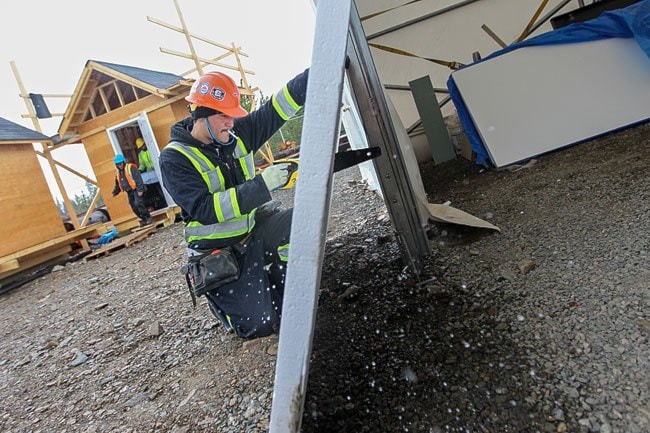Hammer strikes ring loud inside the cabin, competing with the snarl of buzz saws and coarse shouts of professional construction workers pushing forward on a tight timeline.
At least they sound like professionals. They act like them too, and in most ways the 15-person crew building the Carcross Tagish First Nation’s three tiny houses are pros.
Three months ago, they weren’t. Three months ago, they were a bunch of students who - like anyone who has ever sat in a boring class - were not that excited about working on their math modules.
“The math part, I was kind of iffy at first,” says William Germaine as he scribbles notes and tags a bathroom water pipe inside one of the cabins.
“But the steps in the modules, we worked through it step by step. I’m starting to like math and I’m getting better at it,” he says.
Germaine is one of 15 Carcross residents chosen to work on building three tiny homes for the community. The small cabins are about the size of a bachelor appartment, and will be added to the First Nation’s community housing. Like many of the First Nation’s citizens, Germaine has a resume with a lot of itinerant work on it, most of it in far-flung locations across the North.
He’s worked as a logger, slasher, forest fire fighter and has his heavy equipment operator tickets. But for all of his work experience, he couldn’t get a job close to home.
When a friend told him about the tiny homes project, and the chance to get carpentry training alongside important life skills and mentorship, he signed up.
“I just got a call to go up to Inuvik and go work, and it’s isolated, so I’d get good pay but then again it drags me away from my family, which is something that I don’t want,” he says.
“It matters to me. If I do really well, maybe I’ll get hired on full time with the First Nation, or someone else close to home. We all know each other, we’re like a family now. We’re in the union, too. It’s really helpful, preparing us for what’s out there,” he says.
There is an almost boyish pride in his voice as he goes about testing the seals on the three cabins’ plumbing.
And that pride is exactly the point of the project, says Nelson Lapine.
Lapine works for the Carcross Tagish development corporation, and is one of the brains behind the tiny homes.
“The original concept for this initiative was to focus on individuals in the community, because we’ve had complaints from citizens that there was no work,” Lapine says.
“The tiny homes project is actually a byproduct of that,” he says.
“The main focus is actually the individuals; showing up for work, getting to work on time. Many people, myself included, have had problems getting to work on time.”
The program wanted a way to figure out the roots of what Lapine calls “life problems” and help community members fix them.
Instead, it was the program’s students who wound up doing the fixing.
“We told the students that they’re our guinea pigs. They’re going to help us develop the program and come up with solutions. They designed those solutions,” he said.
Along with schooling and skills training, students in the program also get access to a support team and a counsellor to help them overcome other problems in their lives.
Diane Brodeur is that counsellor.
“First of all, some of them have addictions and memories of trauma that you have to overcome; issues of self-confidence, self-worth,” she says.
“They’ve responded really well. I’ve learned a lot more than they have. I have been so humbled by their knowledge, their life experiences and skills they’ve acquired over the years. We told our boss we’d be willing to pay to be part of the next course,” Brodeur says.
The idea of hanging the whole thing on a construction project came from the carpenters union, Lapine said.
They provided the instructors, and in exchange they get to add members to the union’s ranks. The community gets three single-person homes to add to its housing stock and the students learn how to get, keep and excel in a new job. When each student is finished the program, they can challenge Yukon College’s first-year carpentry program for credit and, hopefully, have a leg up in the job market.
“Our whole intent is that every single one of these students will be employable,” Lapine says.
The tiny houses are expected to be wrapped up by the end of May, but that isn’t the end of opportunities for these students.
There’s a multi-million dollar learning centre that will soon be underway, and a new subdivision on Montana Mountain. More long term, there is the swanky eco-lodge planned for Millhaven Bay.
It’s no exaggeration to say that the government is trying to build a new Carcross, and it wants as many of its citizens as possible to be the ones hammering the nails and laying the shingles.
“I’m trying everything humanly possible to get every single one of these students working in the community,” Lapine says.
Contact Jesse Winter at
jessew@yukon-news.com
